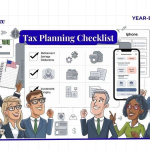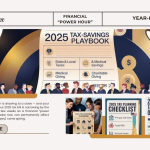Tax Bracket Changes: As we approach the tax year, significant changes to the U.S. tax brackets are set to reshape the financial landscape for middle-income earners. These adjustments, primarily driven by inflation, aim to provide relief and maintain fairness in the tax system. Let’s delve into the key aspects of these changes and examine how they may impact your finances.

Expanded Tax Bracket Changes: More Room to Breathe
The most notable change for 2024 is the expansion of several tax brackets, particularly those affecting middle-income taxpayers. For instance:
- Single filers can now earn up to $47,150 before moving out of the 12% bracket, up from $44,725 in 2023.
- The 22% bracket now extends to $100,525, increased from $95,375 in the previous year.
This expansion allows taxpayers to earn more before being pushed into higher tax brackets, potentially resulting in tangible savings for many households.
Fighting “Bracket Creep”
These adjustments serve a crucial purpose: combating “bracket creep.” This phenomenon occurs when inflation-driven income increases push taxpayers into higher tax brackets without a corresponding increase in real purchasing power. By expanding the brackets, the tax system aims to ensure that middle-income earners, whose wages have merely kept pace with inflation, do not face higher marginal tax rates.
Save Your Tax with Game Mode – Sports to Stocks: Mastering Magic Investment Strategies
Real-World Impact: A Closer Look at Middle-Income Earners
To understand the practical implications, let’s consider two scenarios:
- Steady Income: A single filer earning $50,000 in both 2023 and 2024 would see their federal income tax decrease from $6,164.50 (an effective rate of 12.33%) to $5,979.00 (an effective rate of 11.96%), resulting in a savings of $185.50.
- Income Increase: A single filer whose income rises from $90,000 in 2023 to $95,000 in 2024 would see their effective tax rate decrease from 16.90% to 16.43%, despite the increase in income.
While these changes may seem modest on a per-paycheck basis, they can add up to significant savings over the course of a year.
Know more about Tax Brackets 2024: IRS provides tax inflation adjustments for tax year 2024
2024 Tax Bracket Changes: Comparative Examples of Middle-Income Earners
| Scenario | 2023 | 2024 | Change |
| 1. Single Filer: Sarah | |||
| Income | $60,000 | $60,000 | $0 |
| Standard Deduction | $13,850 | $14,600 | +$750 |
| Taxable Income | $46,150 | $45,400 | -$750 |
| Tax Brackets Used | 10%, 12%, 22% | 10%, 12% | – |
| Total Tax | $5,460.50 | $5,216.00 | -$244.50 |
| Effective Tax Rate | 9.10% | 8.69% | -0.41% |
| 2. Married Couple: John & Emma | |||
| Combined Income | $120,000 | $120,000 | $0 |
| Standard Deduction | $27,700 | $29,200 | +$1,500 |
| Taxable Income | $92,300 | $90,800 | -$1,500 |
| Tax Brackets Used | 10%, 12%, 22% | 10%, 12% | – |
| Total Tax | $10,921.00 | $10,432.00 | -$489.00 |
| Effective Tax Rate | 9.10% | 8.69% | -0.41% |
| 3. Middle Manager: Michael | |||
| Income | $95,000 | $105,000 | +$10,000 |
| Standard Deduction | $13,850 | $14,600 | +$750 |
| Taxable Income | $81,150 | $90,400 | +$9,250 |
| Tax Brackets Used | 10%, 12%, 22% | 10%, 12%, 22% | – |
| Total Tax | $13,160.50 | $14,941.00 | +$1,780.50 |
| Effective Tax Rate | 13.85% | 14.23% | +0.38% |
Key Observations:

- Sarah (Single Filer): Despite no income change, Sarah saves $244.50 due to expanded brackets and increased standard deduction. Her highest marginal rate drops from 22% to 12%.
- John & Emma (Married Couple): With no income change, they save $489 thanks to expanded brackets and a higher standard deduction. Their income now falls entirely within the 12% bracket.
- Michael (Middle Manager): Despite a $10,000 raise, his effective tax rate only increases by 0.38%. The expanded brackets and higher standard deduction help mitigate the tax impact of his substantial raise.
These examples illustrate how the 2024 tax bracket changes can benefit middle-income earners in various situations, whether their income remains steady or increases. The expanded lower brackets and increased standard deduction work together to provide tax relief, even as incomes rise with inflation or career advancement.
Beyond the Brackets: Other Key Changes
It is essential to note that tax brackets are just one component of the tax system. Other adjustments for 2024 include:
- An increase in the standard deduction to $14,600 for single filers
- A rise in the Alternative Minimum Tax (AMT) exemption amount to $85,700 for single filers
These changes, working in tandem with the bracket adjustments, contribute to the overall impact on middle-income taxpayers.
Strategic Planning Opportunities
The new tax landscape opens up several planning opportunities for savvy middle-income earners:

- Timing Income and Deductions: Those near bracket thresholds might consider deferring income or accelerating deductions to optimize their tax position.
- Retirement Account Strategies: The changes may influence decisions about traditional vs. Roth retirement account contributions.
- Charitable Giving: Some taxpayers might benefit from “bunching” donations in alternating years to maximize itemized deductions.
- Maximizing Pre-Tax Contributions: Leveraging Flexible Spending Accounts (FSAs) and Health Savings Accounts (HSAs) can help reduce taxable income.
Regional Considerations of Middle-Income Earners
It is worth noting that the impact of these federal changes can vary significantly depending on location. Factors such as state and local tax burdens, cost of living differences, and regional variations in what constitutes a middle-income level all play a role in the overall financial picture.
Read More and Save More – Tax Hacks Tips for High Earners | Save Thousands on Taxes in 2024
Looking Ahead
While the 2024 adjustments generally favor middle-income earners, it’s crucial to maintain a long-term perspective. These inflation adjustments occur annually, helping to keep the relative value of bracket thresholds over time. However, significant real income growth over several years could still result in movement to higher brackets.

Conclusion
The 2024 tax bracket changes offer a measure of relief to middle-income Americans by adjusting for inflation and potentially lowering their effective tax rates. However, the impact will vary based on individual circumstances. As we navigate these changes, it’s more important than ever for taxpayers to stay informed and consider consulting with tax professionals to understand their specific situations and fully explore new planning opportunities.
Remember, while these changes are generally positive, they represent just one aspect of your overall tax picture. Stay vigilant, plan wisely, and you’ll be well-positioned to make the most of the new tax landscape in 2024 and beyond.
Thank you for reading this post, don't forget to subscribe!






